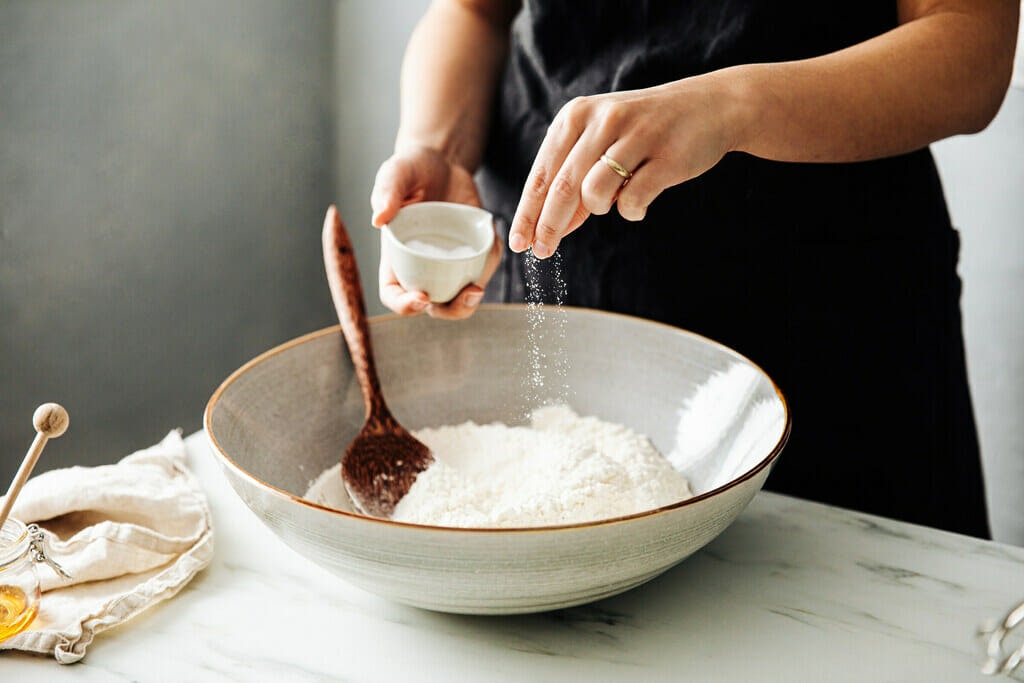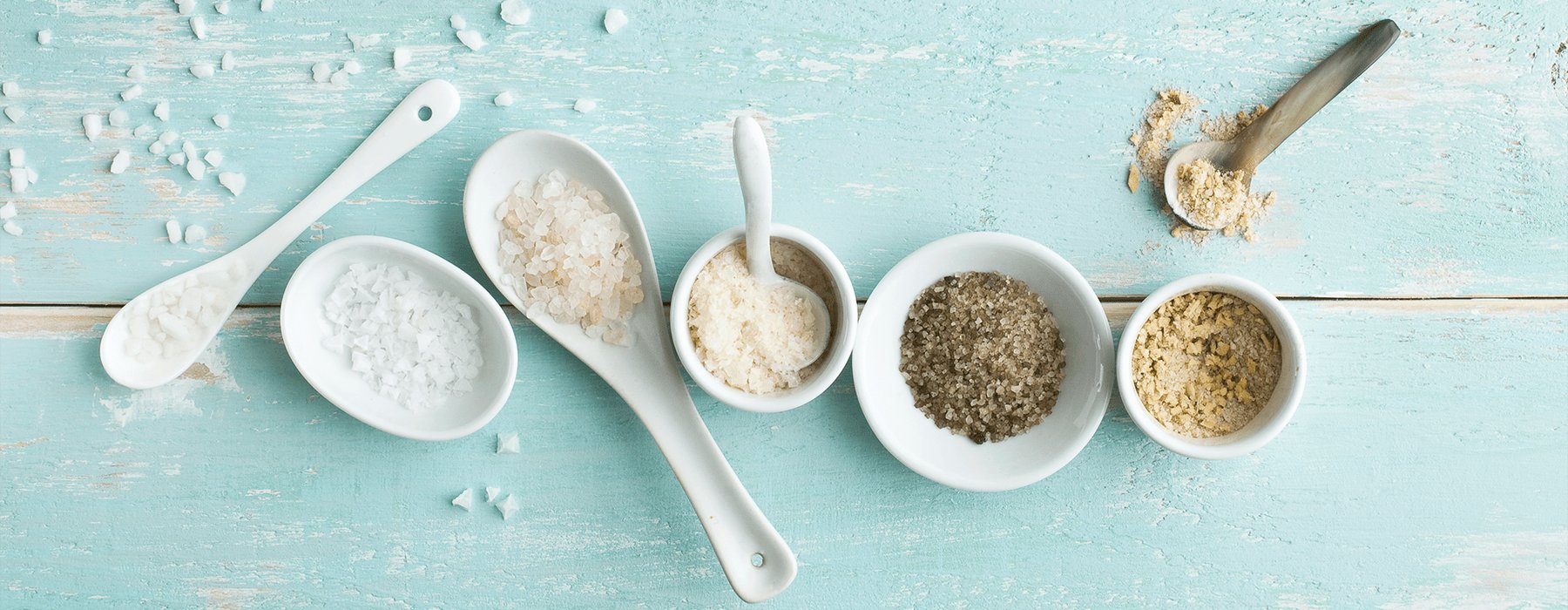No one would begrudge us a pinch of salt to liven up our meals, but at some point that pinch became a generous pour. Niki Bezzant seeks out the latest research on everyone’s favourite mineral and finds easy tips for cutting back without cutting taste.
“Let there be work, bread, water and salt for all.”
The words of Nelson Mandela reflect how essential salt is to life – we need it not only to stay well, but to live well. Many chefs would agree; most would sooner abandon their kitchens than have to live without the flavour-enhancing boost salt gives to dishes.
When it comes to salt and health, though, we are often subjected to mixed messages. Promoters of some fancy salts say their products are loaded with minerals and are good for us, while health experts say too much salt will do us harm. So what’s the latest on this most common of condiments?
We’re soaking in it
Salt is ubiquitous in our food supply in Aotearoa. For most of us, it’ll be the most common food additive we consume. And we’re consuming a lot; on average we eat about eight and a half grams of salt each day. That’s heading towards double the upper limit recommended by health experts, who say we should aim for just one teaspoon (five grams).
Interestingly, it also puts us in the top 10 in the world for salt consumption.
That five-gram recommendation is because of the sodium in salt (salt is sodium chloride), which has been shown to have a detrimental effect on blood pressure and heart health. Although sodium is important for keeping the fluids and electrolytes in our body balanced, too much sodium in our diet can cause our blood pressure to shoot up, and even to become permanently high. When blood pressure is high, the blood that flows through our arteries puts a lot more pressure on the heart and artery walls. Over time, this causes the artery walls to stiffen and narrow. That’s what leads to heart conditions and heart disease.
The Heart Foundation recently released an updated position statement on sodium and heart health, reviewing the body of evidence on the topic. The foundation’s national nutrition adviser, Lily Henderson, says this has reinforced what was already established: eating less salt is better for our health, in most cases.

“The latest evidence continues to show that there’s a strong relationship between our dietary sodium intake and our blood pressure,” she says, “and that there’s a benefit for everyone in the population in reducing their salt intake for long-term heart disease risk.”
Lily says the foundation’s last position statement was in 2011, so this was a long-overdue update. The way we’re eating has changed a bit since then, and salt might have been overlooked amid the demonisation of sugar, carbs and other things in the cycle of dietary trends.
“I think it’s an important reminder, given there are so many different ways of eating and dietary patterns out there. I think salt can often be forgotten.”
But we need salt!
And what about murmurings on social media from some diet exponents that we shouldn’t worry about our salt intake?
Lily says it’s important to consider the established science. “There’s a really strong body of evidence, of high quality, that shows that people who follow a lower-sodium diet have a lower risk of high blood pressure – 21 percent lower – and a 26 percent lower risk of heart disease. And this has been consistently shown. So I think we always need to come back to the body of evidence and what that tells us about how much of an impact our dietary sodium intake can have on our risk of high blood pressure and heart disease.”
Very few of us are at risk of consuming too little salt, she says. “As with anything to do with our health, there’s some genetic predisposition. It really depends on what sort of diet you’re following, or if you’ve got any health or medical conditions, or if you’re taking any medications. There may be people who might be at risk of too little salt or very low blood pressure. But from a population health perspective, our message is still to reduce salt, because we know people are having a lot more than what is recommended.”
Apart from heart health, there’s also some evidence linking high sodium consumption with stomach cancer, though it’s not yet well understood by scientists. The theory is that high salt intakes may encourage the growth of the bacteria Helicobacter pylori in the stomach, which can cause inflammation and stomach ulcers and might lead to stomach cancer. Countries where a lot of salt-preserved foods are traditionally eaten, such as China and South Korea, have high rates of gastric cancers.
Straight from the Himalayas
The range of salts available to us now has expanded from the days when there was just good old fine-grained table salt on the shelves. There’s Himalayan salt, pink salt, rock salt, sea salt and a range of “gourmet” salts of different textures. Some claim to contain useful minerals. We should probably take these claims with – sorry – a grain of salt.
“If you read some of the packaging, they say things like ‘unrefined’, ‘natural’, ‘a source of minerals and trace elements’,” says Lily. “But the amount of these nutrients is so low that there’s unlikely to be any benefit to your health.”

In other words, we’d have to consume a huge amount of salt to get any really useful minerals. She also points out that these salts have the same amount of sodium as regular table salt. And there’s another problem: “The majority of these specialty salts aren’t actually iodised. So if you are using those salts, it’s best to look for an iodised option.”
Iodine is added to salt to compensate for the fact that New Zealand soil is low in iodine, another essential mineral. A lack of iodine can be detrimental to thyroid health, causing issues such as goitre (an abnormal enlargement of the thyroid), and in young children it can lead to mental disabilities. In the days before salt was iodised (in 1924), goitre was a common problem. Also, pregnant women are advised to supplement their diet with iodine for the baby’s brain development. Whatever type of salt we’re using, looking for one that’s iodised is a good idea.
Help for salt-toothed people
Most of us enjoy the taste of salt, especially when it’s combined with fat and sugar, as it often is in processed foods and takeaways. Many of us get most of our salt this way, and it can be hidden in foods we might not think of as salty in flavour, such as breads and cereals. Salt is used in food processing not only for its flavour, but also as a preservative, to maintain crunch and colour, and to stop fermentation. So we might be attuned to a high level of salt in our baseline diets.
We can, though, retrain our palates to enjoy a less salty world. “We looked at the evidence around this,” explains Lily, “and it suggests that it can take anywhere from several weeks up to a few months for our taste buds to fully adapt. There’s actually quite a bit of variation between people, but on our tongues we have between 2000 and 8000 taste buds, and they all have different sensory cells on them that are often regenerated.
“So if you gradually make changes over time, your taste buds will adapt. It could be as simple as starting with one product or one dish that you make often, and then gradually easing back on the salt over time to allow your taste buds to adapt, instead of doing something kind of drastic where you’re going to notice the change quite easily.”
A side benefit might be that we would also refine our palate to tune into other flavours we might have missed in a salty overwhelm.
“I think we can often just use salt out of habit, without actually tasting our food. But if we open the door to all of these other flavours, they’ve all got different taste and sensory properties. So your taste buds may change over time if you are making changes to the way you prepare food.”
Choosing to eat more wholefoods and less highly processed food is a sure-fire way to cut some salt from our lives. Eating lots of vegetables and cooking for ourselves will help too.
Lily is enthusiastic about making small, sustainable changes. “We know that when it comes to forming healthy habits, if we do them gradually, in a way that is feasible and consistent, they’re more likely to stick. It’s great to get into the kitchen and make meals from scratch, because you’ve got a bit more control over the salt and there are lots of opportunities to pack in other flavour.”
Reducing our salt intake is not a one-size-fits-all undertaking. “For some people it might be about having less highly processed foods,” Lily says. “For other people it might be having more meals at home or cooking more. Whatever the approach, start small and do things really gradually so that they can be sustained.”
Tips for cutting down on salt without compromising flavour
Choose processed foods carefully
Because the majority of the sodium we eat is in processed and packaged foods, check the back of the packaging for salty surprises. Compare the per 100g columns on similar foods, and choose the lowest in sodium. “We can often be quite swayed by all of the marketing terms and claims on the front of packs – things like ‘sugar-free’ or ‘plant-based’ or ‘organic’, and we can often forget about salt,” Lily says. “But you might see from the back labels that a product actually has a really high level of salt, even if it doesn’t taste salty.”
Experiment with other flavours
“I really love balsamic vinegar,” says Lily. “I find that quite easy to use in cooking and on salads. I use chilli flakes really often; I’ve got young kids and it’s really hard to cook spicy food, so I’ll often add them myself once the meal’s been cooked. And fresh herbs are great – I make salad dressings with things like thyme or parsley or basil. They are often interchangeable and they add a really good amount of flavour.”
Make simple switches
Swapping a product you use often for a lower-sodium version can be an easy, sustainable change that makes a difference. Try switching your soy sauce, for example. “Focus on that, allow your taste buds to adapt and then look at changing something else.”
Be discerning when eating out
You have no control over the ingredients used in restaurants, but choosing meals from the menu that have a high proportion of vegetables is a good place to start, Lily says. “Be mindful of things that are adding extra salt at the table, like extra condiments and extra salt. The dish is probably already salty enough when it’s brought out to you. Go for dressings and condiments on the side, and avoid things like processed meats, which can contribute a lot of salt too.”
PHOTOGRAPHY: GETTY








